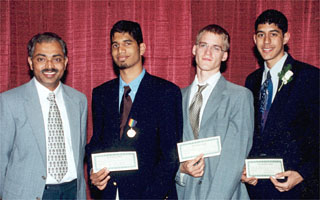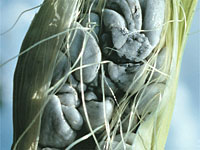
|
By Kisha Shelton,
Plant Pathology Department, University of Georgia
San Jose, CA, played host to approximately 1,200 up-and-coming scientists representing high schools from 39 countries who attended and presented their work at the 52nd Intel International Science and Engineering Fair held May 6-12, 2002. Students competed for numerous prizes and scholarships. The American Phytopathological Society (APS) sponsored two prizes for the competition and three APS members acted as judges for the APS awards. Dr. David Schmale, III (Post Graduate Research, University of California-Davis), Dr. Krishna Subbarao (Associate Professor, University of California-Davis) and Dr. Martin D. Wigelsworth (Technical Crop Manager, Syngenta Crop Protection) reviewed hundreds of projects in the categories of Botany, Biochemistry, Earth and Space Sciences, Chemistry, Environmental Sciences and Microbiology and chose 35 projects that presented work in the area of plant pathology. Projects were judged on creativity, scientific thought, thoroughness, skill, clarity, originality and evidence that the student(s) had significant input in all aspects of the project, including the experimental design.

On behalf of APS, Subbarao presented two awards consisting of a check ($500 for 1st place and $350 for 2nd place), a framed certificate and an APS T-shirt. The 1st place award was presented to Peter Starr and Vivek Kasinath of Keystone School, San Antonio, TX. Their team project, entitled "Initiations of Heat Shock Protein by Viral Invasion: Defense Against or Benefit for Virus?", looked at the production of Heat Shock Protein (hsp) and how it assists in replication of tobacco mosaic virus (TMV), replication of A. tumefaciens, and replication of Nuclear Polyhedrosis Virus. The 2nd place award was presented to A. Benjamin Suri of Harding High School, St. Paul, MN. His project, entitled "Determining Quantitative Trait Loci Associated with Resistance to Fusarium Head Blight on Chromosome 2 of Barley Using Simple Sequence Repeat Markers" determined the location of two genes on chromosome 2 that possibly encode for resistance to Fusarium head blight.
The new school year is well under way, as are the preparations for the 2002 Intel International Science Fair. Many young scientists are working to fill the shoes of the very able and gifted young scientists who so ably presented their work in 2001.
 |
Views: Corn smut is a remarkable disease caused by the basidiomycete fungus, Ustilago maydis. In its early stages, corn smut is a highly prized edible fungus, sometimes called “the smoky maize mushroom.”. Click image for an enlarged view and more information. |
